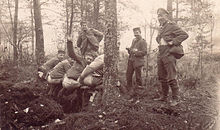| Revision as of 02:56, 22 August 2014 editJarble (talk | contribs)Autopatrolled, Extended confirmed users149,684 edits →Practice: linking← Previous edit | Revision as of 08:17, 26 August 2014 edit undoSchuhmaker747 (talk | contribs)35 editsNo edit summaryNext edit → | ||
| Line 6: | Line 6: | ||
| ==Practice== | ==Practice== | ||
| ] defecating outside during ]]] | ] defecating outside during ]]] | ||
| Open defecation dates back to historical times and also during WW-I (refer photo), a widespread problem in the developing world of African Countries and Asia. The practice is almost associated with areas of extreme poverty, rural regions, inaccessible (by tourists) areas where natives live. | |||
| Open defecation is a widespread problem in the developing world. ]<ref>{{cite web|url=http://www.huffingtonpost.com/2013/11/19/world-toilet-day-india_n_4302900.html |title=On World Toilet Day, World Bank Warns Over 600 Million Indians Defecate In The Open |publisher=Huffingtonpost.com |date=2013-11-19 |accessdate=2014-03-10}}</ref> (with notably higher levels among the ] population),<ref>, economist.com.</ref> with countries throughout Asia and Africa also contributing to the issue. The practice is almost exclusively associated with areas of extreme ]. | |||
| ==Health impact== | ==Health impact== | ||
Revision as of 08:17, 26 August 2014


Open defecation is the practice of defecating outside and in public, in and around your local community, as a result of ingrained cultural patterns or having no access to toilets, latrines or any kind of improved sanitation. It currently affects one billion people in the developing world, or 15% of the global population. It is a practice widely considered to be at the heart of issues around sanitation worldwide.
Practice

Open defecation dates back to historical times and also during WW-I (refer photo), a widespread problem in the developing world of African Countries and Asia. The practice is almost associated with areas of extreme poverty, rural regions, inaccessible (by tourists) areas where natives live.
Health impact
A single gram of human faeces contains as much as 10,000,000 viruses, 1,000,000 bacteria, 1,000 parasite cysts and 100 parasite eggs. When ingested it can therefore lead to typhoid, cholera, hepatitis, polio, pneumonia, fatal worm infestation, trachoma, stunted physical development and impaired cognitive function. It makes open defecation a lead cause of diarrheal death; 2,000 children under the age of five die every day, one every 40 seconds, from diarrhea.
See also
- Sanitation
- Diarrhea
- Manual scavenging
- Trachoma
- Poverty
- Environmental health
- Public health
- Nirmal Bharat Abhiyan
References
- "OpenDefecation.org". 2014-05-28. Retrieved 2014-05-28.
- "Sanitation | International Decade for Action 'Water for Life' 2005-2015". Un.org. 2013-07-24. Retrieved 2014-03-10.
- "Toilets - The Facts - New Internationalist". Newint.org. Retrieved 2014-03-10.
- "Open Defecation and Childhood Stunting in India: An Ecological Analysis of New Data from 112 Districts". Plos One. Retrieved 2014-03-10.
- "WHO | Diarrhoeal disease". Who.int. Retrieved 2014-03-10.